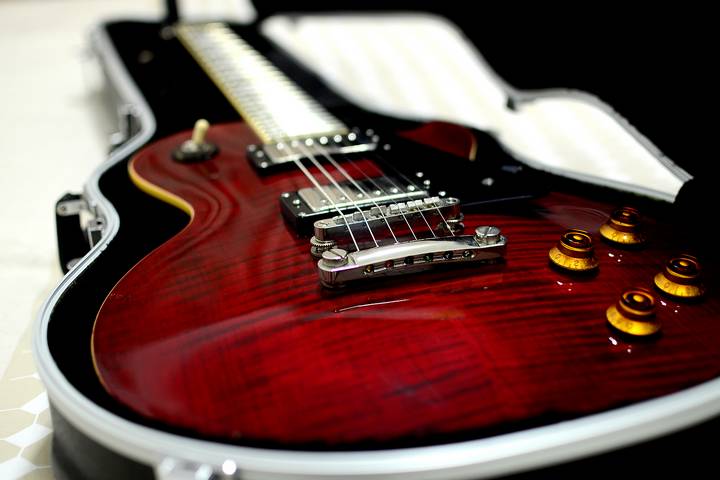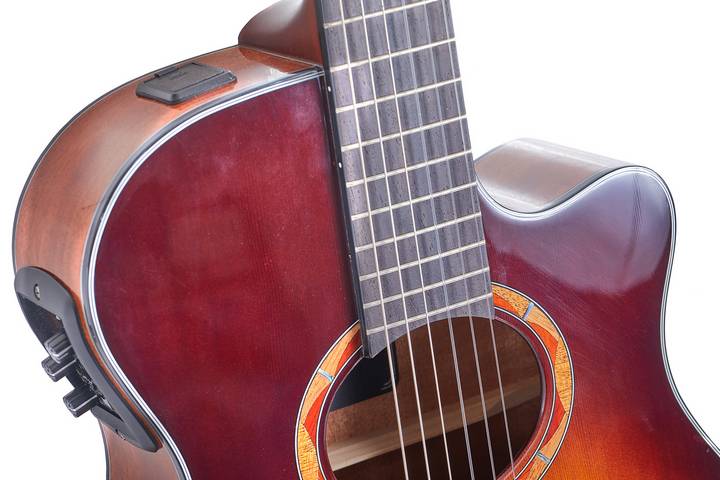9 Best Types of Guitar Finishes and Their Characteristics
Guitar finishes represent the final touch applied to a guitar’s body, neck, and headstock. These finishes serve a dual purpose, functional and aesthetic. On the practical side, they shield the wood from moisture, scuffs, and various environmental elements that could harm the instrument. From an artistic perspective, guitar finishes come in several colours and textures, enabling musicians to personalize based on their style.
Different types of guitar finishes can enrich resonance, influencing its sound properties. Also, guitar finishes increase the visual appeal of the instrument, making it more appealing to players and audiences alike. The assortment of available finishes, such as glossy, matte, satin or vintage, allows individuals to choose one best suited to their artistic tastes and stage presence. A skillfully crafted guitar finish should elevate an instrument’s playability, appearance and sound – ultimately becoming a valued partner for musicians throughout their melodic endeavours.
Discover the best types of guitar finishes and their characteristics.
Type #1: Nitrocellulose Lacquer Finishes

Nitrocellulose lacquer is a beloved classic among guitar finishes. Crafted from the highly flammable and rapidly drying resin of nitrocellulose, this clear, sleek lacquer coating has dominated the guitar industry for generations. Nitrocellulose guitar finish is renowned for amplifying the instrument’s warm tonal properties.
Showcasing an impeccably smooth and lustrous surface, this elegant finish is a hallmark of vintage and upscale guitars. It is meticulously applied in multiple thin layers, ensuring each coating dries and hardens before using the subsequent one. This results in a polished appearance that captures the eye and hearts.
Guitarists hold nitrocellulose lacquer in high esteem due to its remarkable capacity to enhance sound quality. By enabling unobstructed resonance within the wood, this lacquer fosters a rich tonality that appeals to those who desire full-bodied musicality. Furthermore, its irresistibly glossy sheen conveys an air of refinement and luxury, making guitars fitted with this finish show-stoppers on any stage.
Type #2: Polyurethane Finishes

Thanks to its fantastic durability and adaptability, polyurethane has gained quite a reputation as a go-to guitar finish. This synthetic substance comes to life when polyols and isocyanates join forces, creating a robust coating. Polyurethane finishes hold well under everyday pressure and can take some knocks without faltering. Whether you’re into gloss, satin, or matte, polyurethane lets you easily showcase your unique aesthetic flair.
The guitar world praises polyurethane finishes for their outstanding scratch resistance. No longer do guitars need to fear the inevitable dings and dents that traditional coatings often succumb to. Instead, polyurethane delivers enduring protection, keeping guitars impeccably polished for the long haul. This hardiness makes it an ideal finishing choice for those always on the road, gigging at various venues or navigating stage setups.
Type #3: Oil Finishes

Oil finishes refer to natural oils like linseed or tung oil. These popular types of guitar oils enhance and protect the wood’s visual appeal. Unlike other finishes that generate a rigid, plastic-like exterior, oil finishes permeate wood fibres, allowing the instrument to age gracefully. It adds individuality to the guitar that can only transpire through aging and usage.
Renowned for their smooth and organic texture, oil finishes deliver an enjoyable playing experience for musicians. The absence of a dense protective layer enables the wood to vibrate uninhibitedly, enriching the guitar’s tonal attributes. It produces a rich and resonant sound, making oil finishes a sought-after choice among acoustic musicians. Although more frequent reapplication might be necessary than alternative finishes, guitarists who appreciate an earthy aesthetic tend to favour oil finishes.
https://www.traditionrolex.com/4
Type #4: Shellac Finishes

Shellac guitar finishes have been cherished in instrument-making for countless years. Sourced from the lac bug’s secretions and transformed into a resinous substance, shellac finishes are commonly dissolved in alcohol to create a smooth liquid solution. The elegant finish graces the guitar’s wooden surface and dries with a thin protective coating. Vintage or classical guitars often showcase this unique finish, drawing admiration for its traditional allure.
Guitarists enjoy shellac finishes as an eco-friendly alternative to synthetic counterparts. It adds a sense of authenticity to contemporary guitars. Also, shellac can amplify guitar resonance and tonal warmth. Its thin and pliable nature permits the wood to vibrate more freely, culminating in a rich, well-rounded acoustic experience.
Type #5: Water-Based Guitar Finishes

Using water as their solvent, water-based guitar finishes differ from chemicals like alcohol or lacquer thinners. As low emitters of volatile organic compounds (VOCs), they’re gentler on our environment and pose less harm to human health. Available in glossy, satin, and matte varieties, these finishes cater to an extensive assortment of artistic tastes for guitar enthusiasts.
Applying the finish is as simple as spraying or brushing it onto the guitar’s surface, similar to other finishing methods. Once dried, it forms a crystal-clear, sturdy protective coating that elevates the wood’s aesthetic appeal.
Guitarists like using water-based finishes. Their minimal VOC emissions result in a purer and safer workspace during application. Also, these finishes are celebrated for their resistance to yellowing over time, ensuring the wood’s natural hue remains true for years. This allows the wood grain to take centre stage, infusing the guitar with sophistication. Plus, with their speedy drying time, water-based finishes cut down on production duration.
Type #6: French Polish Finishes

French Polish is a classic guitar finish renowned for its application method and striking appearance. It employs a shellac-based concoction on the wood through a technique known as padding. A thin coating emerges by continuously applying layers using circular movements, integrating flawlessly with the wood grain. The labour-intensive process needed to create this refined look makes French Polish synonymous with upscale classical guitars.
The slender and organic shellac layer showcases the true splendour of the wood, giving the guitar a sophisticated appearance. This finish adapts to different temperatures and humidity levels, allowing the wood to breathe freely. French Polish guitar finish is widely acclaimed for its warm tonal attributes, creating a deep and complex sound. Another advantage is its repairability. Minor abrasions or imperfections can be easily restored without extensive refinishing.
Type #7: High Gloss Finishes

High gloss finishes create a smooth and reflective surface, giving the guitar a polished appearance. Achieving this high gloss effect involves carefully applying multiple clear coats or lacquer layers, which are expertly buffed until perfectly finished. The finish serves as a protective barrier against scratches, preserving the instrument’s pristine condition over time. You can find this stunning finish on various guitar styles, from acoustic to electric.
Often praised for their visual charm and luxurious touch, high gloss finishes exude elegance and professionalism. The reflective quality of this finish adds depth and dimension to the guitar’s overall look. Beyond mere aesthetics, the multiple layers of the clear coat create a sturdy shield for the wood underneath, ensuring resilience during extensive use. Likewise, high gloss finishes are easily cleanable and maintainable, allowing your instrument to retain its brilliant shine.
Type #8: Satin Finishes

Satin finishes grace guitars with a muted appearance, setting them apart from their high gloss counterparts. Guitars with satin finishes offer a delightfully natural feel since their texture highlights the wood grain’s tactile presence. This finish attracts guitarists who appreciate a subtle look and cherish the satin surface’s velvety touch during their performances.
Satin finishes blend visual appeal with durability. Their refined charm entices those who prefer a more classical look. The non-reflective surface diminishes glare and fingerprint marks, streamlining cleaning processes. Plus, the gentle nature of satin finishes conceals minor scratches or wear far better than high gloss finishes. The silky texture is a delightful bonus, especially for guitarists who savour the raw connection to the wood grain of their instruments.
Type #9: Matte Finishes

Matte finishes have become popular among guitar enthusiasts, offering a sleek, non-reflective surface with a modern touch. Unlike their glossy or satin counterparts, these finishes display a toned-down look. Matte finishes reduce reflections on the guitar by employing specialized materials capable of scattering light. Guitarists drawn to a minimalist and contemporary look find matte finishes the right choice for their instruments. These finishes lend an uncluttered vibe to the guitar’s design while letting the natural wood grain shine through.
Guitarists enjoy matte finishes because they minimize fingerprints and glare. This results in fewer maintenance requirements. The subdued finish suits various musical genres, such as rock and folk. It provides an inconspicuous canvas for guitarists to prioritize performance and musical expression. For those with a penchant for personalization, matte finishes can easily be embellished with creative artwork or decals.
